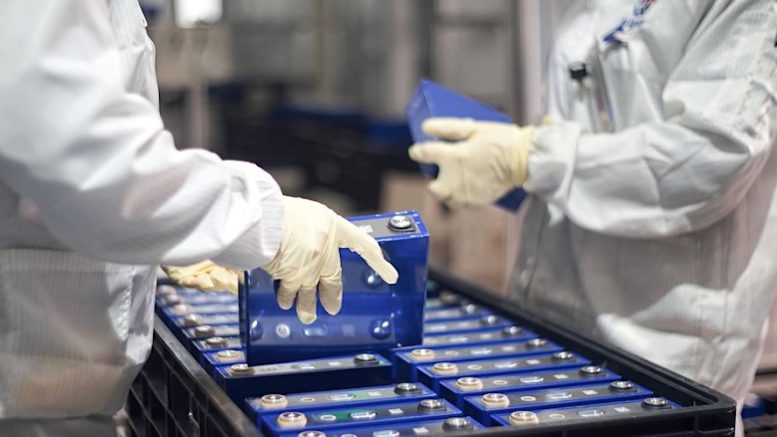On January 5, General Motors CEO Mary Barra unveiled the Chevrolet Silverado electric pick-up truck at CES 2022, one of the most influential technology conferences in the world. The full-size plug-in truck she said during her keynote presentation will have a range of 400 miles (640 kilometres) on a full charge and will go on sale in the spring of 2023.
The truck was built on GM’s so-called “Ultium” EV platform—a unit of battery modules that can be configured to suit different models. The Silverado has fast-charging capabilities of up to 350kW, enabling about 160 km (100 miles) of range to be added in ten minutes. The pickup truck will be able to accelerate from zero to 60 in less than four and a half seconds and will be produced at GM’s Factory ZERO assembly center in Detroit, which the company says has been “repurposed and retooled with a US$2.2 billion investment devoted to EV production.”
During her 54-minute presentation, Barra, an engineer who became GM’s CEO in January 2014 and chairman of the board two years later, talked about the company’s pledge to become carbon neutral by 2040. “To help us meet that goal, we are on track to invest US$35 billion in electric and autonomous vehicles by 2025, powering our plans to launch more than 30 electric vehicles globally over that same time frame,” she declared. The company intends to have all new light-duty and heavy-duty vehicles be electric by 2035.
“We plan to convert more than 50% of our manufacturing footprint in North America and China to EV production by 2030,” Barra continued. “To meet the demands for batteries we believe that we have one of the most vertically integrated supply chains for battery production in the industry.” GM already has two battery plants under construction today in Ohio and Tennessee, she said, and two more U.S.-based battery plants are being planned. In addition, GM is investing nearly three quarters of a billion dollars through 2025 to expand access to EV charging stations in the U.S. and Canada, she said. In addition to the Silverado, GM has also developed the GMC Hummer electric SUV and the Cadillac Lyriq.
But Barra and the folks at GM know all too well that the road to an all-EV future is going to get very congested. While GM was one of the first to delve into the sector, it still faces considerable competition from both traditional rivals like Ford Motor Co., and from more recent EV entrants like Tesla and new start-ups like Rivian Automotive Inc.
Ford Motor’s F-150 Lightning pickup truck is expected to debut in limited numbers this year, and there are already nearly 200,000 reservations for it. On January 4, the company announced that it plans to double production of the F-150 in order to meet the demand. The F-150 will offer consumers two battery choices, a standard range of 230 miles and an extended battery range of 300 miles. In September it unveiled plans to build two new battery plants in Kentucky and another in Tennessee, along with an electric truck plant, with joint-venture partner and battery cell supplier SK Innovation of South Korea. The total investment of US$11.4 billion, Ford said, was the largest in the carmaker’s 118 year history. Ford is targeting to have 40% to 50% of its global vehicle volume fully electric by 2030.
Meanwhile, Rivian sold its first electric pickup truck — the R1T — with a range of about 314 miles— last year, and in December announced that it will spend US$5 billion on building a second plant in the state of Georgia, east of Atlanta. The facility will start production in 2024 and churn out about 400,000 vehicles a year. Rivian, in which Amazon owns about a 20% stake, is also scaling capacity (a 623,000 sq. ft. expansion) at its existing plant in Illinois.
Tesla plans to start initial production of its Cybertruck in 2023, and last year sold an estimated 936,000 electric cars. Other companies have big plans, too. Stellantis announced in July last year that it will invest over €30 billion (US$35 billion) in electrification and software through 2025, and is targeting more than 70% of its vehicle sales in Europe and more than 40-45% of vehicle sales in the U.S. to be “low-emission vehicles” (LEV) by 2030. “Each of the company’s 14 iconic brands is committed to offering best-in-class fully electrified solutions,” the company, which was formed last year through the merger of Fiat Chrysler and Peugeot of France, said in a press release.
For its part, Mercedes-Benz Ag says it plans to go all-electric by 2030, and in mid-December, Toyota said it plans to roll out 30 battery EV models by 2030. Startups like Lucid Motors (recently started customer deliveries of its Lucid Air EV); Fisker (taking pre-orders now for its Fisker Ocean SUV model arriving this year); and Canoo (taking pre-orders for launch in late 2022) are also charging ahead with EV plans, while Foxconn Technology Group outlined prototypes for three EVs in October last year.
The bottom line for our industry is that EV-makers big and small need to make deals with mining companies — and fast. This week we saw junior Talon Metals announce a six-year offtake deal with Tesla to supply the carmaker with 75,000 tonnes of nickel in concentrate from its 51%-owned Tamarack project in central Minnesota. The project isn’t even close to being in production yet and the agreement is also conditional on Talon Metals earning a 60% stake in the project.
Worries about adequate charging stations and range anxiety are being overtaken by concerns about where these EV manufacturers are going to source all the metals and minerals required to make the batteries that will drive their cars and pickups. And we’re going to see more deals and partnerships with mining companies big and small — underscoring the critical role the industry is playing in one of the biggest transformations in modern history.






Be the first to comment on "From EV pickups to sedans, miners can bank on bright future"